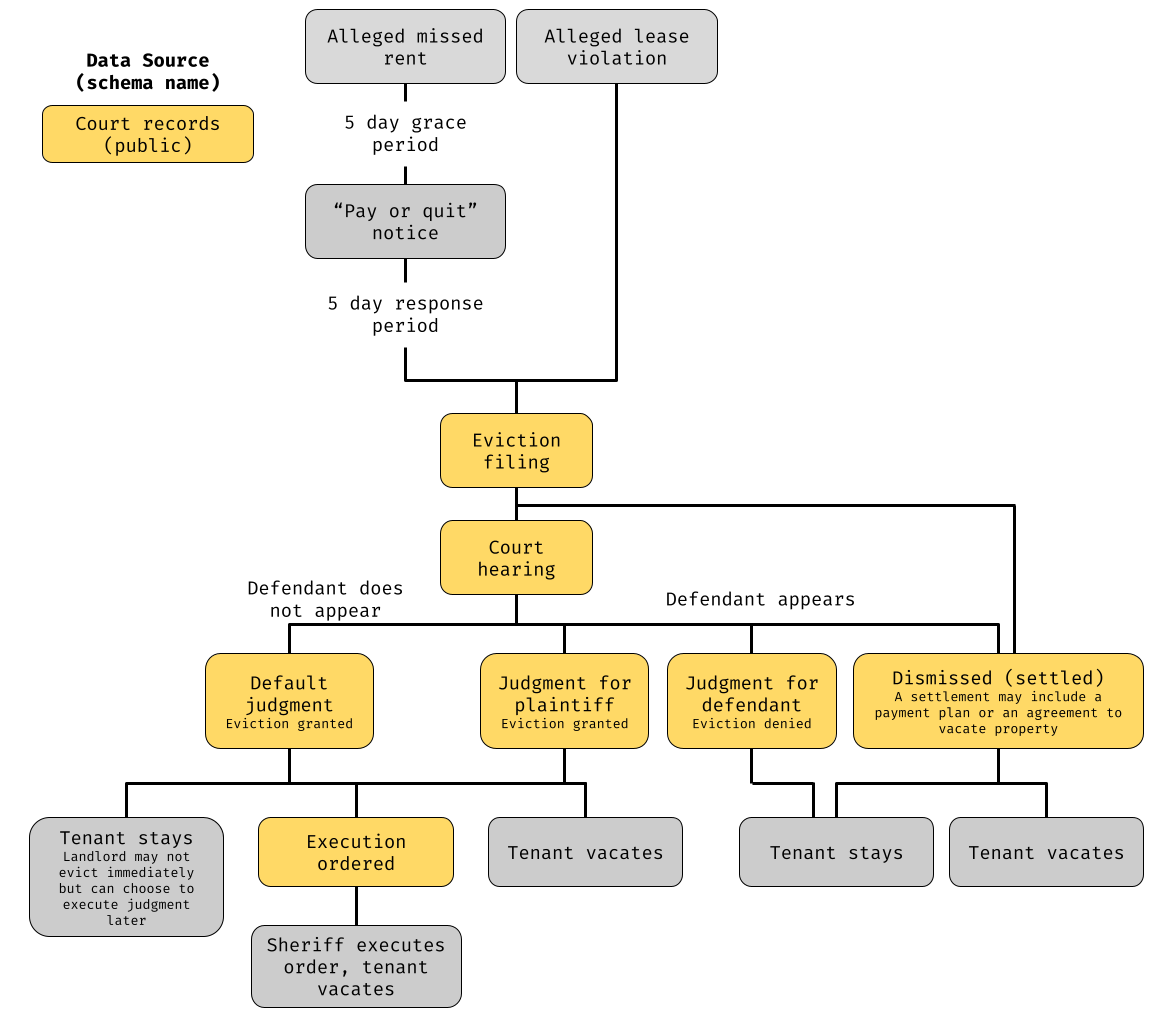Chapter 8 Civil Justice Process and Methodology
Civil cases occur when a party files a civil suit against another party. Our work on civil cases primarily deals with eviction cases, formally known as “Forcible Entry and Detainer” cases filed in small claims court.
8.1 Eviction flowchart
Our eviction data comes from OSCN. While we can capture many of the key moments of an eviction case, including the filing, the hearing, and the disposition, much of what happens does not appear in court records. It is also important to remember that many evictions - though we don’t know how many - occur informally when a landlord illegally changes the locks, turns off utilities, or takes other action to force a tenant to vacate the property. We have no means of measuring the frequency of these actions.

Eviction flowchart
8.2 Processing Eviction Case Data
The raw data we get from an individual case record on OSCN must be processed and summarized before it’s useful in analysis. Clean, standardized case-level eviction data can be queried from the ojo_civ_cases table. This section describes that process and the decisions that go into it.
The level of detail available in case record varies from county to county based on the system used by the court (see OSCN: Oklahoma district court records for more on that). Some variables are only available for OSCN counties, and some are available only for Tulsa County. It’s important for a data analyst to understand what data is available when having conversations with stakeholders who have a raft of questions that we may or may not be able to answer.
8.2.1 Defining an eviction case
Each eviction case has a unique case number assigned by the court of filing. Even if an eviction case includes more than one defendant, it is counted as one eviction filing (by contrast, see Defining criminal a case).
In most counties, eviction cases are filed with the issue “Forcible entry and detainer,” but some counties use other language, like “rent” or “eviction.” While an eviction can be filed under several case types, we focus on cases filed in small claims court (case type “SC”). Not all small claims cases are evictions.
8.3 Eviction glossary
Default judgment: If one party fails to appear for an eviction hearing, the case is ruled in favor of the party that does appear. We assume that when a default judgment is entered, the case results in a judgment in favor of the landlord. If the landlord (plaintiff) fails to appear, the case is dismissed.
Defendant: The defendant in eviction cases is the tenant. A judgment for the defendant means the eviction filing does not result in an eviction (see eviction/eviction filing below)
Eviction/eviction filing: We distinguish between an eviction filing, where a landlord files a case, and an eviction, where the court rules in favor of the plaintiff and the tenant is ordered to vacate the property.
Informal eviction: In addition to evictions that happen through the formal legal process, landlords often illegally force tenants out of their homes by changing locks or turning off utilities. We call these “informal evictions,” and researchers estimate that they occur five or more times as often as formal evictions.
Issue: The issue of a civil case corresponds to the subject matter of the case. An eviction case usually has the issue “Forcible entry and detainer,” while cases where a creditor is suing for unpaid debt has the issue “indebtedness” or “promissory note.” This is the equivalent of a “count” or “charge” in a criminal case.
Plaintiff: The plaintiff in eviction cases is the owner of the property; this can be a property management company, an individual landlord, or a specific apartment complex.